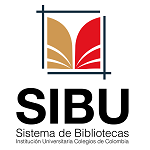SIBU - SISTEMAS DE BIBLIOTECAS UNICOC
Estado del arte de los cementos de ionómero de vidrio
por Roca Perez, Hansel Giovanny ; Ardila Gamboa, Estefanía
; Ardila Gamboa, Estefanía ; Vivas Garia, Agnny Karina
; Vivas Garia, Agnny Karina .
.
Editor: Bogotá (Colombia): Institución Universitaria Colegios de Colombia - UNICOC; 2017Tema(s): Odontología / Prostodoncia - Tesis y disertaciones académicas| Tipo de ítem | Ubicación | Signatura topográfica | Número de copia | Estado | Fecha de vencimiento | Código de barras | Reserva de ejemplares |
|---|---|---|---|---|---|---|---|
 Trabajo de Grado Trabajo de Grado |
Bogotá (Dr. David Ordóñez Rueda) - Campus Norte
Campus Norte Biblioteca de la Institución Universitaria Colegios de Colombia |
T.O.Pr.0081 (Navegar estantería) | Ejemplar 1 | Disponible | 20162TOPr0081 |
Incluye tabla de contenido y referencias bibliográficas.
Asesores científicos: Dra. Carolina Lara Jimenez; Asesor Metodológico: Diana Parra Galvis.
RESUMEN
OBJETIVO: Describir como ha sido la evolución de los cementos de ionómero de vidrio (CIV).
MÉTODOS: Se realizó una revisión de literatura de documentos encontrados en las bases de datos: Sciencedirect, EBSCO y PubMed. Dentro de la búsqueda en las bases de datos se filtraron los artículos por periodos de 1938-1970 (Pasado), 1970-2000 (Presente) y 2001-actualidad (Futuro). Para evaluar la estructura y calidad de la evidencia se utilizó la plantilla Scottish Intercollegiate Guidelines Network (SIGN) y así poder establecer los grados de recomendación.
RESULTADOS: Los resultados según las estrategias de búsqueda fueron 6.208 artículos. El total de resúmenes seleccionados según los criterios de inclusión y exclusión fueron 417. Fueron elegidos y recuperados 169 artículos texto completo. Después de una nueva evaluación, 96 artículos fueron excluidos por no cumplir con los criterios y ser artículos repetidos. Por lo tanto 73 artículos fueron incluidos, 61 estudios experimentales, 11 revisiones de literatura y 1 revisión sistemática que cumplían con los criterios y contenían datos e información precisa y adecuada.
CONCLUSIÓN: El desarrollo a futuro de los CIV probablemente aporte mejoras en la resistencia a la fractura y el desgaste, así como también en las propiedades estéticas. Estas mejoras permitirán que el material aumente su longevidad en situaciones de carga, permitiendo así que el material se convierta en una alternativa viable a otras restauraciones. Otras de las nuevas características hacia la cual se enfocaran los estudios de desarrollo de este material dental, será la optimización de las propiedades biomimética, biomineralizantes o antimicrobianas para proporcionar CIV de nueva generación.
ABSTRACT
OBJETIVE: Describe the evolution of glass ionomer cements (GIC) through time.
METHODOLOGY: A literature review was gone based on documents found in the following databases: Sciencedirect, EBSCO and PubMed. Within the search in data bases, articles were screened by periods of 1938-1970 (past), 1970-2000 (present) and 2001-currently (future). To evaluate the structure and quality of the evidence a Scottish Intercollegiate Guidelines Network (SIGN) template was used in order to establish the recommendation degrees.
RESULTS: The results according to the search strategies were 6.208 articles. The total of summaries that were selected following the inclusion and exclusion criteria was 417. 169 full context articles were selected and recovered. After a new assessment, 96 articles were excluded as were not meeting the inclusion criteria, due to repeated information. Therefore, 73 articles were included, 61 experimental studies, 11 literature reviews and 1 systematic revision that met the criteria and had precise and appropriate data and information.
CONCLUSION: The future development of the GIC will probably provide improvements in fracture and wear resistance as well as in aesthetic properties. These improvements will allow the material to increase its longevity under load situations, allowing the material to become a viable alternative to other restorations. Other new features that will focus on the development of this dental material will be the optimization of the biomimetic, biomineralizing or antimicrobial properties to provide new generation GIC
Palabras clave: Cement, Glass Ionomer; Polyalkenoate Cement; Glass Polyalkenoate Cements; Glass Ionomer Cement; Cement Glass-Ionomer; Silicate Cement; Polycarboxylate Cement; Tricalcium Silicate ; - Key words: Cement, Glass Ionomer; Polyalkenoate Cement; Glass Polyalkenoate Cements; Glass Ionomer Cement; Cement Glass-Ionomer; Silicate Cement; Polycarboxylate Cement; Tricalcium Silicate.
© 2014 UNICOC | Institución Universitaria Colegios de Colombia - UNICOC
Bogotá D.C. Autopista Norte Km. 20. Teléfono:(571)6683535
Cali: Calle 13 Norte No. 3N-13. Teléfono: (572)6608887




